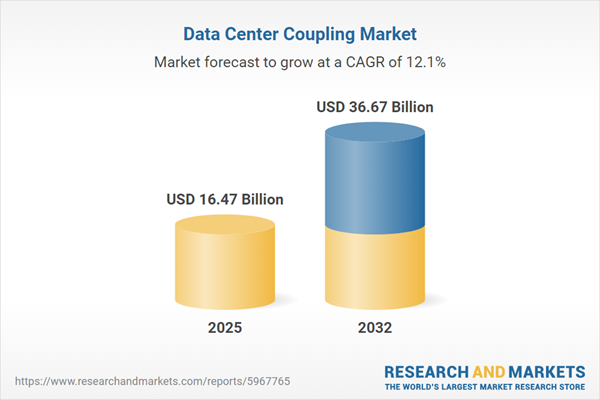Speak directly to the analyst to clarify any post sales queries you may have.
As digital infrastructure becomes more complex and compliance demands evolve, investment in the data center coupling market enables organizations to achieve secure, resilient, and integrated operations. Senior leaders prioritize solutions that enhance uptime, streamline management, and support strategic agility as technology and regulatory frameworks change.
Market Snapshot: Data Center Coupling Market Growth
The data center coupling market is set for robust expansion, with a projected rise from USD 14.69 billion in 2024 to USD 16.47 billion in 2025 at a CAGR of 12.11%. Accelerating adoption is driven by enterprise-wide IT modernization, shifting regulatory priorities, and a strong need for integrated, secure platforms across both public and private sectors. Organizations are channeling resources into advanced coupling technologies to achieve streamlined workload management and seamless infrastructure integration. These trends are further supported by mounting pressure to maintain continuous operations and align technology investments with evolving business priorities, enabling flexible responses to new compliance standards and digital objectives.
Scope & Segmentation of the Data Center Coupling Market
- End User: Colocation providers leverage flexible coupling for diverse client demands; enterprises seek tailored deployments to meet distinct operational goals; public sector agencies emphasize compliance and data security; hyperscale operators focus on standardized integration for global consistency.
- Tier: Deployment ranges from reliability-focused Tier I facilities serving essential workloads to complex Tier IV environments, allowing organizations to map infrastructure to their business continuity needs.
- Cooling System: Air, liquid, and immersion cooling are increasingly incorporated to address high-density and mission-critical operations, with a growing emphasis on sustainability and energy efficiency.
- Rack Density: Infrastructure supports an extensive range of deployments, from traditional low-density setups to advanced high-density configurations essential for analytics and AI applications.
- Component: Reliable operation depends on resilient electrical and mechanical components, including batteries, chillers, CRAC units, UPS systems, switchgear, backup generators, and transformers, each playing a key role in minimizing downtime risk.
- Power Capacity: Market offerings address everything from compact, latency-sensitive edge installations to large-scale, scalable campus infrastructure designed for future growth.
- Region: Distinct adoption drivers are evident in the Americas, EMEA, and Asia-Pacific. Local technology standards and regulatory imperatives influence uptake, with rapid innovation in countries such as the US, Germany, China, and India reflecting region-specific strategies and challenges.
Key Takeaways for Senior Decision-Makers
- Unified coupling of power, cooling, and mechanical systems increases operational stability, benefiting both centralized and distributed data center models.
- Modular and distributed architectures at the edge provide agility to adjust quickly in line with shifting compliance requirements and dynamic market forces.
- Investments are moving toward efficient, sustainable cooling, with liquid and hybrid systems establishing themselves as leading approaches to meet environmental benchmarks.
- Coordinating infrastructure and compliance strategies builds transparent governance that supports operations across increasingly regulated environments.
- Advanced thermal management is a crucial enabler for reliable performance in workloads driven by analytics and artificial intelligence, supporting continuous service delivery.
Tariff Impact on Data Center Coupling Supply Chains
Recent US tariffs have increased acquisition costs and extended lead times for core components, including steel enclosures and specialized cooling systems. In response, organizations are diversifying their supply networks, exploring local sourcing options, and investing in modular facility designs. These measures help maintain project timelines and continuous operations, ensuring procurement strategies address changes in supply reliability and policy landscapes.
Methodology & Data Sources
This report uses a combination of executive and procurement leader interviews, thorough document reviews, and multi-disciplinary validation workshops. This approach delivers relevant findings tailored to strategic decision-makers in the data center sector.
Why This Report Matters
- Supports leadership in aligning infrastructure initiatives with changing compliance, risk, and digital transformation goals, helping maximize operational value.
- Guides procurement and operations teams through strategic updates as technology and regulatory landscapes evolve regionally and globally.
- Offers actionable recommendations aimed at balancing modernization with environmental targets, empowering organizations to confidently navigate ongoing data center trends.
Conclusion
Ongoing modernization of IT infrastructure requires integrated approaches to meet new compliance and performance standards. Collaboration among technical, operational, and compliance teams is essential for sustainable, future-ready data center operations.
Additional Product Information:
- Purchase of this report includes 1 year online access with quarterly updates.
- This report can be updated on request. Please contact our Customer Experience team using the Ask a Question widget on our website.
Table of Contents
3. Executive Summary
4. Market Overview
7. Cumulative Impact of Artificial Intelligence 2025
Companies Mentioned
The companies profiled in this Data Center Coupling market report include:- Cisco Systems, Inc.
- Ciena Corporation
- Huawei Technologies Co., Ltd.
- Juniper Networks, Inc.
- Nokia Solutions and Networks Oy
- Arista Networks, Inc.
- Infinera Corporation
- Dell Technologies Inc.
- Hewlett Packard Enterprise Company
- Fujitsu Limited
Table Information
| Report Attribute | Details |
|---|---|
| No. of Pages | 190 |
| Published | November 2025 |
| Forecast Period | 2025 - 2032 |
| Estimated Market Value ( USD | $ 16.47 Billion |
| Forecasted Market Value ( USD | $ 36.67 Billion |
| Compound Annual Growth Rate | 12.1% |
| Regions Covered | Global |
| No. of Companies Mentioned | 11 |









